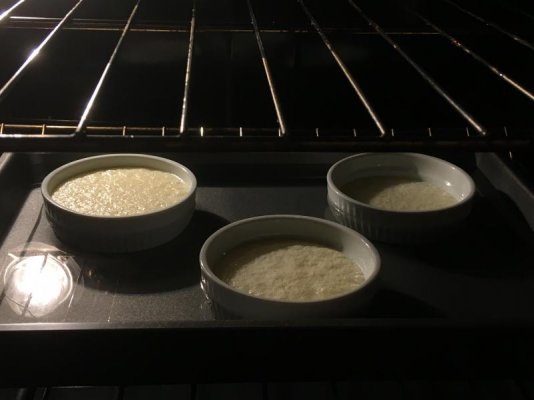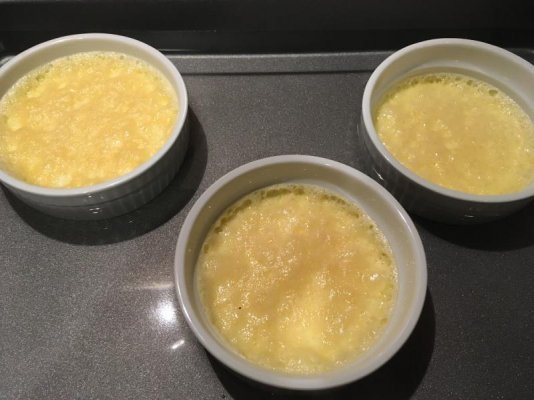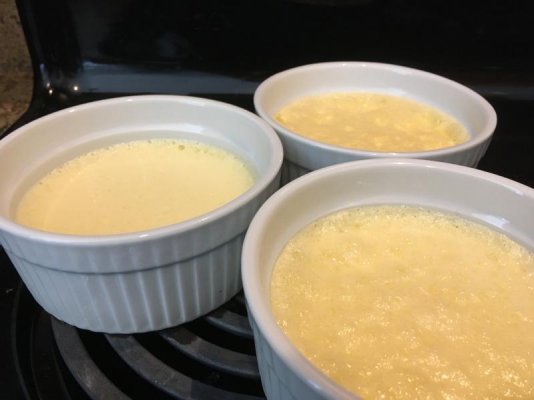CookingNoob
Assistant Cook
I've been trying to hone my Creme Brulee skills this week. Results have been... let's say mixed.
Namely I'm having difficulty with the baking process. I'm hoping somebody can shed some light on what I might be doing wrong.
Issue #1: The tops are cooking much faster than the centers. As such, after about 30 minutes at 300, a rough, textured, eggy-looking film starts to develop on top of the custards.
If I jiggle the dishes, it doesn't look like the trademark jello jiggle, but more like semi-cooked, eggy-looking foam atop pure liquid. Almost like a cappuccino.
Issue #2: Of all the recipes I read, the average "optimal" temperature to bake the dishes to is 170-175 (give or take.) So why is it that when my creme brulees reach this temp, they are still pure liquid in the center? Shouldn't they have "set" by now?
So basically I have a couple questions I'd like anybody to take a crack at
1: How do I prevent the top from cooking quicker than the rest?
2: Are the top and center of the dish supposed to be roughly the same consistency when I take them out of the oven? Or is it actually ok that the center is pretty liquidy?
3: Why is it that my creme brulee reach the optimal temperature, but are still mostly liquid? If 175 is the optimal temperature, shouldn't they be "set" by now?
I'm using a pretty standard recipe:
5 egg yolks
2 cups heavy cream
1/8th tspn salt
1/2 cup sugar
1 vanilla bean
heat cream/vanilla/salt to simmer
whisk yolks & sugar until pale and smooth
let cream cool to below 165, & slowly stir into eggs
cook in water bath at 300 for 25-35 minutes
Any help with all of this would be much appreciated.
Namely I'm having difficulty with the baking process. I'm hoping somebody can shed some light on what I might be doing wrong.
Issue #1: The tops are cooking much faster than the centers. As such, after about 30 minutes at 300, a rough, textured, eggy-looking film starts to develop on top of the custards.
If I jiggle the dishes, it doesn't look like the trademark jello jiggle, but more like semi-cooked, eggy-looking foam atop pure liquid. Almost like a cappuccino.
Issue #2: Of all the recipes I read, the average "optimal" temperature to bake the dishes to is 170-175 (give or take.) So why is it that when my creme brulees reach this temp, they are still pure liquid in the center? Shouldn't they have "set" by now?
So basically I have a couple questions I'd like anybody to take a crack at
1: How do I prevent the top from cooking quicker than the rest?
2: Are the top and center of the dish supposed to be roughly the same consistency when I take them out of the oven? Or is it actually ok that the center is pretty liquidy?
3: Why is it that my creme brulee reach the optimal temperature, but are still mostly liquid? If 175 is the optimal temperature, shouldn't they be "set" by now?
I'm using a pretty standard recipe:
5 egg yolks
2 cups heavy cream
1/8th tspn salt
1/2 cup sugar
1 vanilla bean
heat cream/vanilla/salt to simmer
whisk yolks & sugar until pale and smooth
let cream cool to below 165, & slowly stir into eggs
cook in water bath at 300 for 25-35 minutes
Any help with all of this would be much appreciated.




